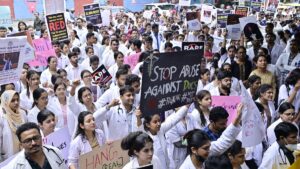
India Doctors End One-Day Strike Over Colleague’s Rape and Murder: A Reflection on Healthcare and Justice
On August 18, 2024, a poignant chapter in India’s ongoing struggle for justice and safety unfolded as doctors across the nation ended a one-day strike that had been ignited by the tragic rape and murder of a colleague. Dr. Priya Sharma, a young and respected physician, had been the victim of a heinous crime that sent shockwaves through the medical community and beyond. This strike, while brief, highlighted deep-seated issues within the Indian healthcare system and broader society, revealing a critical intersection between professional solidarity and the fight for justice.
The Tragic Incident
Dr. Priya Sharma was not just a healthcare professional but a symbol of dedication and compassion. Her brutal murder in early August shook the medical community, with the circumstances of her death—violence and violation—bringing to light the vulnerabilities faced by women in India. The horrific nature of the crime spurred an immediate and passionate response from her peers, who were grappling with both grief and outrage.
Dr. Sharma’s colleagues, particularly those from her hospital in New Delhi and others nationwide, quickly mobilized to demand justice. They were not only mourning the loss of a friend and colleague but also protesting the systemic issues that they felt contributed to the crime. The demand was clear: justice for Dr. Sharma and a serious examination of the factors that allowed such a tragedy to occur.
The Strike: Solidarity and Protest
The one-day strike, which began on August 17, saw thousands of doctors across India cease their professional duties. Hospitals were disrupted, and patient care was temporarily halted as doctors took to the streets and social media platforms to voice their demands. The strike was not merely about expressing sorrow but was a powerful statement against the rampant violence against women and the insufficient legal protections available to them.
For many, the strike was a moment of solidarity, a demonstration that the medical community could come together to fight against injustices. It was also a reflection of the broader societal frustration with the pace of legal proceedings and the frequent lack of adequate protection for women. The decision to strike was not taken lightly, given the potential impact on patient care, but the urgency of the situation drove many to prioritize the fight for justice over their daily responsibilities.
The Response from Authorities
The Indian government and law enforcement agencies were swift to respond to the outcry. Senior officials assured the public that the case would be thoroughly investigated and that the perpetrators would be brought to justice. Additionally, there were promises to review and strengthen policies related to women’s safety and to address the systemic issues highlighted by the strike.
However, the response from authorities was met with a mix of skepticism and cautious optimism. Many in the medical community and the public remained wary, demanding tangible actions rather than just statements of intent. The strike underscored the need for ongoing vigilance and pressure to ensure that promises translate into concrete changes.
Broader Implications for Healthcare and Society
The strike and the tragic circumstances that led to it opened a broader dialogue about the safety of professionals working in high-risk environments and the societal attitudes towards women. It highlighted several critical areas for reform:
- Healthcare Professionals’ Safety: The violence against healthcare workers, particularly women, is a significant concern. Ensuring the safety of doctors and medical staff should be a priority, with measures such as improved security in hospitals and better support systems for staff facing threats.
- Legal Reforms: The case emphasized the need for stringent legal reforms to address violence against women. Faster judicial processes, harsher penalties for offenders, and better support for survivors are essential components of this reform.
- Public Awareness and Education: Increasing public awareness about gender-based violence and fostering a culture of respect and equality are crucial for preventing such crimes. Educational campaigns and community engagement can play a vital role in changing societal attitudes.
- Systemic Support for Victims: Beyond legal measures, providing psychological and emotional support to survivors and their families is critical. Institutions and communities must be equipped to offer comprehensive support during the aftermath of such tragedies.
Moving Forward
The end of the strike does not signal the end of the struggle. Instead, it marks the beginning of a renewed commitment to address the issues raised by Dr. Sharma’s tragic death. The medical community’s response, while impactful, must be followed by sustained efforts to ensure that such tragedies become less frequent and that justice is effectively served.
As India moves forward, the hope is that the collective actions of doctors and the public will lead to meaningful changes. The goal is not only to seek justice for Dr. Priya Sharma but also to foster an environment where such violence is less likely to occur and where every individual’s safety is a priority.
In the end, the strike served as a powerful reminder of the strength and unity that can arise in the face of adversity. It also underscored the ongoing need for vigilance, advocacy, and action to protect those who dedicate their lives to caring for others. The tragedy of Dr. Sharma’s death is a call to action for all to work towards a safer and more just society.
